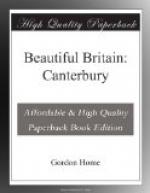Throughout the centuries succeeding this crowning glory of Canterbury, the little walled city saw many great functions apart from the yearly stream of pilgrims of every grade of society, and the huge doles of food and drink given away by the two great monasteries and the lesser houses of the city must have brought together an unwholesome concourse of the needy.
Every fifty years after the translation of Becket’s remains to the great shrine there was a special festival on July 7, when the people of the archiepiscopal city would find their resources strained to the very uttermost in feeding and housing the great assemblage. The martyrdom took place on December 29, but owing to the time of the year this festival did not draw so many as the summer one. All through the year the pilgrims came and went, and instead of falling off in numbers as the martyrdom receded, the popularity of the saint did not reach its zenith until the fifteenth century. Royal visits were of frequent occurrence, and of all the cities of England, after London, Canterbury would appear to have entertained more distinguished personages than any other.
Between 1378 and 1411 Prior Chillenden pulled down Lanfranc’s Norman nave and transept, which had survived the fire, and rebuilt them in the Perpendicular style, then prevailing. When this work was finished and the south-western tower had been completed, in 1481, there was not much left of the Norman priory church built by Lanfranc. The north-western or Arundel Tower, the last survival of Lanfranc’s church, was rebuilt in 1840 and made to match its Perpendicular neighbour and the central tower—the external masterpiece of the cathedral—commenced by Prior Molashe in 1433, and completed by Prior Selling in the closing years of the century. The piers supporting this tower are Norman with a later casing, and the foundations of the nave walls belong to the same period.
Having reached its greatest glories, Canterbury began to decline, and the dissolution of the two great monasteries and the demolishing of Becket’s shrine must have been to the city, on a much larger scale, what the sweeping away of all the Shakespearean landmarks and relics from Stratford-on-Avon of to-day would imply. Nevertheless the city could afford to present Queen Elizabeth with l. 30 in a scented purse when she came thither in 1564, and the fact that Canterbury remained the chief centre of the authority and state of the English Church prevented the city from decaying. And even if this dignity had not remained the position of the town in relation to the comings and goings between England and France would have saved it from any sudden fall from its opulence and greatness before the dissolution.




